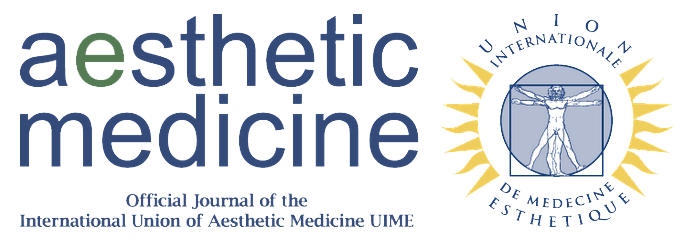Typical symptoms of Body Dysmorphic Disorder (BDD) in patients seeking preventive and corrective medical-aesthetic treatments: analysis of differences and potential predictors
Keywords:
Body Dysmorphic Disorder (BDD), Medical-Aesthetic Treatments, Social Media Comparison, Preventive vs. Corrective Treatments, Psychological Predictors, Patient ScreeningAbstract
Background: Body dysmorphic disorder (BDD) is a condition characterized by excessive concern for perceived physical defects, often associated with the demand for medical aesthetic treatments. However, psychological differences between patients seeking preventive or corrective treatments and possible predictors of BDD remain unclear.
Aim: This study analyzed symptomatic and behavioral differences between patients requesting preventive and corrective medical aesthetic treatments, assessing the presence of typical BDD symptoms and possible predictors to improve screening, reduce inappropriate treatments, and optimize clinical approaches.
Methods: A total of 136 participants completed online self-report questionnaires investigating demographic and anamnesis data and motivations for medical aesthetic treatments. The COPS, MAIA, IACS, and E-pgm questionnaires assessed BDD symptomatology, body perception, social media comparison, and post-procedure expectations.
Results: Among participants, 56.6% belonged in the corrective group, while 43.4% were in the preventive group. The corrective group had significantly higher scores in COPS (p = 0.01), social media comparison (p = 0.001), and post-treatment expectations (p = 0.01), whereas the preventive group showed higher body confidence (p = 0.05). In the preventive group, BDD correlated with social media comparison (r = 0.575, p < 0.001) and post-treatment expectations (r = 0.403, p = 0.004), whereas in the corrective group, BDD correlated with age, body perception, dissatisfaction, self-esteem, and post-operative expectations (p < 0.001).
Conclusion: In the preventive group, social media comparison was the only predictor of BDD, while in the corrective group, age, body perception, and social media comparison were significant predictors. BDD is often underdiagnosed and may lead to post-treatment dissatisfaction. A thorough screening of expectations and psychological characteristics could reduce the risk of inappropriate interventions, improving selection criteria for medical aesthetic treatments and patient satisfaction.
References
1. Phillips KA, McElroy SL. Insight, overvalued ideation, and delusional thinking in body dysmorphic disorder: theoretical and treatment implications. J Nerv Ment Dis. 1993; 181(11):699-702.
2. Möllmann A, Dietel FA, Hunger A, Buhlmann U. Prevalence of body dysmorphic disorder and associated features in German adolescents: a self-report survey. Psychiatry Res. 2017; 254:263-267.
3. Frías Á, Palma C, Farriols N, González L. Comorbidity between obsessive-compulsive disorder and body dysmorphic disorder: prevalence, explanatory theories, and clinical characterization. Neuropsychiatr Dis Treat. 2015; 11:2233-2244.
4. Angelakis I, Gooding PA, Panagioti M. Suicidality in body dysmorphic disorder (BDD): a systematic review with meta-analysis. Clin Psychol Rev. 2016; 49:55–66.
5. DSM-5 Changes: Implications for child serious emotional disturbance [Internet]. Rockville (MD): Substance Abuse and Mental Health Services Administration (US). 2016; 52–54.
6. American Psychiatric Association (APA). Diagnostic and Statistical Manual of Mental Disorders, Fifth Edition (DSM-5).
7. Phillips KA. The broken mirror: understanding and treating body dysmorphic disorder. Oxford University Press. 2005
8. Veale D, Neziroglu F. Body dysmorphic disorder: a treatment manual. Wiley-Blackwell. 2010
9. Phillips KA, Menard W, Quinn E, Didie ER, Stout RL. A 4-year prospective observational follow-up study of course and predictors of course in body dysmorphic disorder. Psychol Med. 2013; 43(5):1109–1117.
10. Reddy KK, Besen J. Body dysmorphic disorder: epidemiology and specific cohorts. In: Vashi NA, ed. Beauty and body dysmorphic disorder. Switzerland: Springer International Publishing. 2015; 127–137.
11. Hartmann AS, Buhlmann U. Prevalence and underrecognition of body dysmorphic disorder. In: Phillips KA, ed. Body dysmorphic disorder: advances in research and clinical practice. New York. Oxford University Press. 2017; 49-60
12. Phillips KA, Menard W, Fay C. Gender similarities and differences in 200 individuals with body dysmorphic disorder. Compr Psychiatry. 2006; 47:77–87.
13. França K, Roccia MG, Castillo D, et al. Body dysmorphic disorder: history and curiosities. Wien Med Wochenschr. 2017; 167(Suppl 1):5–7.
14. Fardouly J, Vartanian L R. Social media and body image concerns: current research and future directions. Curr Opin Psychol. 2016; 9:1-5.
15. Holland G, Tiggemann M. A systematic review of the impact of the use of social networking sites on body image and disordered eating outcomes. Body Image. 2016; 17:100-110.
16. Schwoebel J, Coslett HB. Evidence for multiple, distinct representations of the human body. J Cogn Neurosci. 2005; 17(4):543-553.
17. Gallagher S. Body image and body schema: a conceptual clarification. J Mind Behav. 1986; 7(4):541-554.
18. Veale D, Gledhill LJ, Christodoulou P, Hodsoll J. Body dysmorphic disorder in different settings: a systematic review and estimated weighted prevalence rates. Body Image. 2016; 18:168-186.
19. Crerand CE, Franklin ME, Sarwer DB. Body dysmorphic disorder and cosmetic surgery. Plast Reconstr Surg. 2006; 118(7):167e–180e.
20. Veale D, De Haro L, Lambrou C. Cosmetic rhinoplasty in body dysmorphic disorder. Br J Plast Surg. 2003; 56(6):546-551.
Downloads
Published
Issue
Section
License
Copyright (c) 2025 Chiara Donatelli, Domenico Centofanti, Emanuele Bartoletti, Silvia Cerea

This work is licensed under a Creative Commons Attribution-NonCommercial 4.0 International License.
This is an Open Access article distributed under the terms of the Creative Commons Attribution License (https://creativecommons.org/licenses/by-nc/4.0) which permits unrestricted use, distribution, and reproduction in any medium, provided the original work is properly cited.
Transfer of Copyright and Permission to Reproduce Parts of Published Papers.
Authors retain the copyright for their published work. No formal permission will be required to reproduce parts (tables or illustrations) of published papers, provided the source is quoted appropriately and reproduction has no commercial intent. Reproductions with commercial intent will require written permission and payment of royalties.

This work is licensed under a Creative Commons Attribution-NonCommercial 4.0 International License.





